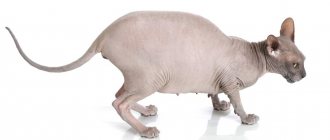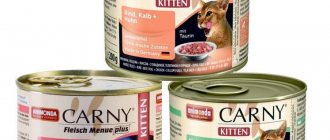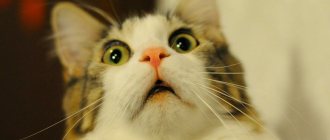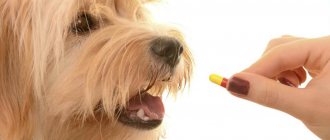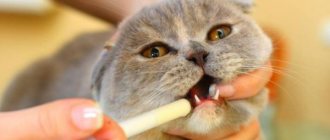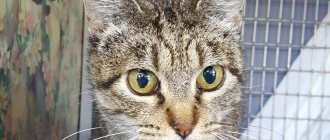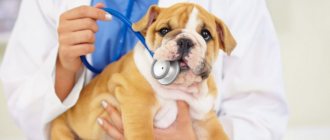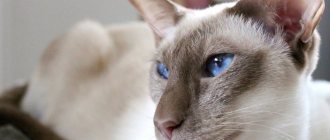Features of digestion depending on age
Cats belong to the order of carnivores, the class of mammals.
Immediately after birth, the baby needs mother's milk. With it, he receives micronutrients, proteins, vitamins, fats and, most importantly, immunoglobulins, which form the immune system of the future predator. The mother feeds the offspring until they are three months old. The enzyme lactase is produced in the small intestine of kittens. It is responsible for the digestion of milk sugar (lactose).
Mother's milk
From a month on, the cubs gradually begin to taste meat. The amount of breast milk consumed decreases, but it still takes up a significant part of the diet. As the kitten grows up, serious changes occur in its body. Lactase production decreases. The digestive system produces more and more proteases necessary for the breakdown of proteins.
Three months is the age when a kitten becomes an adult and stops receiving milk from its mother. By this point, the body has already adjusted to a meat diet, and lactase practically ceases to be produced. There is not enough enzyme to process lactose, so milk causes unpleasant symptoms (pain, diarrhea) in most adults.
What's wrong with the cat or reasons for the lack of milk
Normally, cats produce milk immediately after the end of labor. It can also arrive only 2-3 hours after the kittens are born.
If the babies squeak loudly, their tummies are empty, and they try to constantly suckle their mother, it means that there is no milk in the cat’s mammary glands.
This happens for the following reasons:
Stress. Pets giving birth for the first time can be very nervous and aggressive. They cannot understand what is happening to them, they worry and even abandon their offspring.
Endometritis or pyometra. Such diseases are a consequence of inflammation of the uterus. With pyometra, a large amount of pus accumulates in its cavity. In this case, you can determine what is wrong with the cat by the symptoms: heavy breathing and shortness of breath, the appearance of purulent discharge from the noose, restless behavior.
Not released afterbirth. Normally it should come out within a couple of hours. If this does not happen, the animal is given an injection of the drug Oxytocin.
Eclampsia. With this disease, an acute deficiency of calcium occurs in the cat’s body. The animal begins to have convulsions. The pet is worried, walks poorly, hides, and refuses to feed the babies.
Mastitis. This term refers to inflammation of the mammary glands in a cat. At the same time, they become hot and hard. The animal is in severe pain and does not allow the kittens to approach the nipples.
Lack of maternal instinct. In rare cases, a cat does not produce milk after giving birth, so she refuses to accept her babies, since her maternal instinct does not awaken.
Incorrect and poor diet. If your cat doesn't get enough nutrients from her diet during pregnancy, she may not produce milk after giving birth.
Details
Basic Rules
We present the basic rules, following which you can figure out how to raise and feed a 1-month-old kitten without a cat at home:
1. Food for a one-month-old kitten should have a liquid consistency. Solid inclusions and pieces should be avoided. The kitten will hardly be able to digest such food. 2. When feeding a small kitten for up to a month, use various feeding devices. Bottles with rubber nipples can serve as such devices. 3. Each new product is introduced into the diet gradually and in small portions. 4. Do not overfeed your baby. Control the amount of food in the bowl. 5. Introduce new foods into the kitten’s diet not immediately, but gradually. Give each new product every 3-4 days.
IMPORTANT: Provide the kitten with clean drinking water in the required quantity.
How to train a one-month-old kitten to eat on its own
The kitten begins to show interest in adult food at the age of 3 weeks.
He watches with interest how other animals eat. Complementary feeding should begin with dairy products. Pour milk into a saucer, dip your finger in it and let the kitten lick it. The baby will understand that it’s delicious and will reach for the cup himself.
Then you can poke the kitten's muzzle into the milk, but be careful not to choke. In any case, give the kitten freedom of movement and freedom of choice. He himself will reach for a cup of milk and start lapping it up. Don't think that you will succeed the first time. Be patient and repeat the procedure again. It is normal for the kitten to snort and sneeze.
A baby kitten can get its paws right into the bowl. To wean your kitten from such a bad habit, wipe its wet paws every time.
Hold him by the neck so he doesn't go all the way into the bowl. Be patient with your little pet and after a few days the kitten will learn to eat on its own. The owner of a kitten is always conflicted about whether it is better to feed the kitten dry food or natural food.
Cat breeders debate the benefits all the time. Ready-made cat food is a balanced product. The manufacturer adds everything you need to it: vitamins, healthy additives and microelements. From the point of view of veterinarians, dry food is worthy food for an animal.
Cautions
But with any approach, you need to recall important features:
- If you start feeding your kitten natural products, do not add dry food to its food. The fact is that the process of digesting dry food and natural food is different. Therefore, if you do not want your animals to encounter problems such as gastroenteritis and gastrointestinal colic, then do not feed natural food and dry food at the same time.
- You should not feed your kitten with industrial food of different brands at the same time, this will either lead to an excess of some vitamins or to vitamin deficiency. Digestive problems are also possible.
- Don’t skimp on your pet’s health, buy proper and high-quality food. The kitten should be fed with a product of the “Premium” and “Superpremium” classes.
If you decide to feed your kitten natural food, then adhere to the following rules:
- Diet variety. If from an early age an animal gets used to one type of food, then in the course of its life it will hardly be possible to accustom it to another. Offer your kitten a variety of foods.
- You should not feed your kitten food from your table. Human food contains salt and spices that are harmful to cats.
So what should you feed a one-month-old kitten, besides milk?
You can give complementary foods in the form of cottage cheese. Stir cottage cheese with milk until it reaches a consistency similar to sour cream. The next product that you will introduce into the diet of a month-old kitten is chicken yolk, but it should also be mixed with milk. Porridge with meat and milk broths, soups with broth without spices, and boiled vegetables are good for a kitten.
You can use different products, the main thing is that they are not greasy and are well chopped. Kittens should not be given meat from fatty animals, such as pork, goose, and duck. Add organ meats to your food. Meat should not be given to a kitten raw; it must be boiled first. Fish should not be given to cats often. Frequent consumption of fish leads to kidney disease. For castrated animals, fish is excluded from the diet altogether.
The food of a small kitten should be close to natural. Food should be warm and natural. Do not feed foods that are too hot or very cold. Make sure that the kitten always has clean water.
Feeding regimen or how many times should a kitten be fed 1 month old:
1. Kittens up to two weeks old are fed at least 7 times a day. All feedings are divided into equal time intervals. 2. Kittens aged from 2 weeks to 1 month are allowed to eat 6 times a day. 3. A kitten older than 1 month should receive food 6 times a day in small portions.
A single serving of food for a one-month-old kitten is 30 ml per 100 g of weight. A kitten over 1 month of age is given 50 ml per 100 g of food weight at a time.
Feeding kittens, when to start feeding?
In cats, colostrum appears immediately after lambing. It is a milk-like liquid with beneficial components. Colostrum is valuable for its antibodies - they provide kittens with immunity from the first days of their birth. Colostrum turns into milk and becomes the main food that provides babies with proteins, fats, vitamins, and carbohydrates. Kittens are born blind, but with a good sense of smell. This is what allows you to quickly and accurately find the mother’s nipples.
- Number of cubs born. If the baby is alone, then the mother can feed him for up to 4 months, and sometimes even longer if solid foods are introduced. But when there are 5-6 babies in a litter, the duration of feeding is significantly reduced. It could be a month or a month and a half.
- Individual characteristics of a cat. Many of them feed their young for a long time, allowing even older and stronger ones to come to them. Sometimes this lasts up to six months. Others do not feed their offspring for more than a month, stop allowing them to drink juices, hiss, and run away. There are also mothers who refuse to feed their offspring altogether. But this is rather an exception rather than a rule.
- Quality of mother's diet. A complete cat diet is the key to long-term feeding of offspring. It is especially important that taurine and calcium enter the mother’s body during this period.
READ The cat's respiratory rate is normal. Pulse in cats: basic information and method of measurement
Hello friends, today I’m answering questions from my viewer. Andrey asks when and what to feed the little ones...
After the birth of furry creatures, owners often wonder how much milk the cat feeds the kittens with milk. For newborn animals, milk is the main source of energy and nutrients. Therefore, it is important to have an idea of the duration, frequency and other key points of keeping and feeding newborn kittens.
Almost immediately after lambing, the cat produces colostrum. This is a milk-like substance containing a large number of useful components. Colostrum is especially rich in antibodies, which provide immunity to newborns in the first days of life.
Gradually, the level of antibodies decreases, and colostrum becomes mother's milk. For newly born babies, it is the main food for several weeks.
Only with the secretion of the mammary gland can kittens receive proteins, fats, carbohydrates and substances necessary for the normal development of the body.
Kittens are born blind, but with a good sense of smell, which allows them to accurately find the source of milk - the mother's nipples. In the first week of life, babies are fed to the breast about 10 - 12 times a day. When the cubs are 7 days old, the interval between feedings increases slightly, and the cat feeds the kittens 8 times a day. In the fourth week they switch to 6 feedings a day.
Many factors influence how long a cat feeds her kittens with milk:
- Number of babies in the litter. A healthy cat can feed one kitten for up to 3 - 4 months, and sometimes longer (provided it is fed solid food). If there are 5 - 6 cubs in a litter, then the animal is not able to feed them with mother's milk for a long time.
- Individual characteristics of the animal. Some females feed kittens for quite a long time, allowing the grown cub to approach them, even when it reaches 5-6 months of age. Other animals, after 3-4 weeks, and sometimes earlier, stop feeding the kittens with milk, preventing them from getting to the nipples. And some cats completely refuse babies. The duration of feeding is individual and depends on the specific animal.
- Quality of nutrition for a nursing mother. How much a cat feeds her kittens depends on the animal's diet. A complete diet that provides the nutrients and minerals necessary during feeding (especially calcium, taurine, etc.) contributes to a longer period of lactation and feeding.
- Mom's health. How long a cat spends feeding her kittens is influenced by the physiological state of the mother at the time of feeding. Diseases of internal organs, postpartum complications, the presence of worms and parasites reduce the milk production of the animal and shorten the period of admission to the breast.
On average, a healthy domestic cat feeds kittens continuously for 3 to 4 weeks, during which time milk is their only source of nutrition. Then they begin to feed the babies solid food.
It is important to start feeding the cubs on time, since from the age of one month, the components of milk are no longer sufficient for the normal development of a rapidly growing organism. Animals are fed chicken, beef, diluted cow's milk, cottage cheese, and yogurt.
From this time on, breastfeeding is carried out 3-4 times a day.
By the time the cat stops feeding the kittens milk, the kittens should be able to feed themselves solid food. Babies completely switch to independent feeding at 2 - 2.5 months. From this time on, their body does not need mother's milk, it does not meet the growing needs of kittens, and they are able to digest non-liquid food.
Can kittens have milk from a cow?
If, for a number of reasons, a kitten can no longer feed on mother’s milk, the owner is faced with the task of choosing the most suitable analogue. The first thing that comes to mind is cow's milk. This product is widely represented on the market, it is affordable and can be found in any store. But can you give it to a kitten? Unfortunately, there are many reasons why this choice should be abandoned.
Cow's milk is intended for newborn calves. Its composition is rich in vitamins and beneficial microelements, many of which are suitable for cat babies. But some substances are not needed by the kitten’s body and are even dangerous:
- the protein contained in cow's milk can cause diarrhea or allergies;
- estrogen is a female hormone present in the milk of a pregnant cow, which negatively affects the kitten’s hormonal levels;
- antibiotics that cows receive on farms can cause dysbiosis;
- Some of the pesticides contained in cow feed end up in the milk and can cause severe poisoning in a kitten;
- pasteurized dairy products from the store are practically devoid of nutrients and beneficial substances.
Feeding with cow's milk
TOP 7 popular vitamin complexes
Today, veterinary stores and pharmacies offer a large selection of vitamin complexes and supplements for pregnant cats.
- "Doctor Zoo" Taking vitamins from this manufacturer prevents the development of microelement deficiency in the body of a pregnant cat, and also promotes the proper development of future kittens. The big advantage of this vitamin complex is that it is produced in Russia, as a result of which it is quite affordable. The cost of a standard pack does not exceed 100 rubles.
- "Seva". Seva Sante Animal is the official representative of the French brand in the Russian Federation. It is believed that the products of this brand are of high quality and meet European standards. The line is represented by many different vitamin complexes. Because of this, it would be best if your veterinarian can tell you which product is best for a pregnant cat. The big advantage of the vitamin supplement is its price - it is a little more than one hundred rubles.
- "Logs." The counters of zoological stores offer several series of these products. The most suitable vitamin complex for pregnant and lactating cats is Excel 8 in 1. The composition of this product is rich in all the vitamins and microelements necessary for the pregnant body, and also contains amino acids, brewer's yeast and protein. In this regard, it is suitable not only for pregnant women, but also for nursing cats. "Logs" supports the immune system and helps the animal recover as quickly as possible after giving birth. As a rule, the price of a package of these vitamins is about 300 rubles.
- The feed additive Unitabs MAMA+Kitty takes excellent care of expectant and nursing mothers and their offspring. It contains a complete complex of nutrients: folic acid, magnesium, zinc, iron, iodine, vitamin A and B vitamins, taurine and natural antioxidants. The rich composition of this vitamin supplement will help the pregnant mother’s body cope with viruses and infections and protect her kittens from developmental pathologies. The average price of this product is not too high - 250-300 rubles.
- Vitamin and mineral supplement “Joy” helps normalize metabolism and facilitates the period of gestation of kittens. In addition, this product contains probiotics, which help eliminate digestive problems for the expectant mother. The undoubted advantage of this vitamin complex is its low cost, because a package of 90 tablets costs approximately 200 rubles.
- "Farmavit NEO" This vitamin and mineral complex normalizes metabolism, stimulates the immune system, prevents hypovitaminosis in pregnant and lactating cats, and also ensures the full intrauterine development of kittens. The price of a pack is about 600 rubles.
- "Canina" The products of this brand are the most popular for pet owners. Vitamin supplements from this German manufacturer cannot be called cheap - the average cost of one package is approximately 600 rubles. However, this product justifies its cost, since it reliably protects kittens in the womb from all kinds of pathologies, and also supports the body of a pregnant female.
Features of goat milk
Goat's milk is better for kittens than cow's milk. Its composition is more acceptable to their body.
Goat milk has a number of undoubted advantages over cow milk:
- in terms of fat content it is closer to cat fat;
- fats and proteins are easily digestible;
- low-allergenic;
- contains less lactose;
- contains a lot of lacto- and bifidobacteria, which have a positive effect on the intestinal microflora and the digestive process;
- a significantly higher percentage of vitamins and mineral compounds.
If there are no contraindications, kittens can be given goat's milk. To reduce the fat content, it must first be diluted with water.
It is very important to buy the product from trusted farmers, making sure in advance that the goats are healthy, well-nourished and kept in decent conditions.
Features of the diet of a nursing cat
During lactation, the animal should receive complete natural nutrition. There should be no chemical additives in food. Due to ongoing lactation, mother cats feel a greater need for water. Drinking should be not only in the form of water, but also in the form of milk. It restores strength and nutrients well.
Meat broths are very useful for cats. They not only replenish fluid needs, but are also a source of valuable nutrients. The broth should be prepared using lean meats - it will bring a lot of benefits. Salt and spices are harmful to cats, so the broth should be without these components.
Nursing cats need more food. Do not limit her diet, but on the contrary, make sure that there is always fresh food in her bowl.
The role of protein in the diet of a nursing cat
Protein is the main building material of the cat's body. All tissues are formed with the help of protein. During lactation, part of the protein goes into the formation of milk. And the quality of breast milk and the health of her kittens depend on what to feed a nursing cat.
With a lack of protein in cats, protein metabolism is disrupted. This, in particular, leads to exhaustion and the development of rickets. To ensure that the animal does not experience protein deficiency, the daily diet should include: ⦁ Fish (sea fish only). ⦁ Eggs. ⦁ Cream, cottage cheese, sour cream, kefir. ⦁ By-products. ⦁ Beef, as well as poultry and lean pork (boiled). ⦁ Cereals (best oatmeal, buckwheat). ⦁ Wheat germ and grass for cats.
Milk during feeding
A kitten, left without a mother from the first days, needs adequate nutrition for normal development. The owner's first step is to try to get cat milk for the little pet. To do this, you need to find a nursing cat and give her another baby. If this method fails, it's time to think about an alternative.
Many pet food manufacturers produce special complementary foods that will become the baby’s main diet until he is one month old. These are mixtures that include milk powder, cream, yeast, eggs, as well as all the elements necessary for growth.
The preparation process is simple - pour liquid into the powder and mix thoroughly. Usually a daily supply is prepared immediately, which is kept in the refrigerator to preserve its benefits and freshness. Before feeding, the required amount of the mixture is heated to 38 ⁰C.
Veterinarians recommend adding a little more liquid to the powder than indicated on the package. This will help avoid constipation.
Various feeding mixtures
When making a choice in favor of one or another product that replaces mother's milk for kittens, you need to consider several points:
- the manufacturer and brand must be well-known and have positive reviews from specialists and breeders;
- The breed of the pet largely determines the required calorie content of the mixture;
- fat content – for children the limit value is 9%.
Meat puree can be gradually introduced into the menu of a bottle-fed kitten from the age of one month.
How to keep newborn kittens without a cat?
In addition to a constant source of nutrition, babies need warmth, a feeling of fullness, and a mother’s heartbeat. This is why the best option is to find a nursing cat. However, if it is not there, there are ways to deal with such a situation. You will have to put in a lot of effort.
How to keep newborn kittens without a cat:
- Please note that newborn kittens are not much different from human babies. They also need to be fed initially every 2 hours, then every 3 hours.
- If there is no cat, the kittens get dirty and can get stuck in their feces. Therefore, it is necessary to moisten the disc in warm water and wipe the entire kitten completely. This will also serve as a kind of massage that will help the kittens with their bowel movements.
- You should be prepared for the fact that newborn kittens may suffer from constipation due to an incompletely formed digestive system. It is for these purposes that animal massage is performed.
- Check the temperature in the nest from time to time. It should be at 30 degrees. In the second and third weeks, a temperature drop of 24-27 degrees Celsius is allowed.
Cat
General recommendations
- When babies are one month old, teach them to have short but regular separations from their mother. Let the four-legged little one spend a couple of hours a day in his own “house” with dishes, a bed and a toilet.
- If the kitten does not yet know how to eat from a bowl, it is placed on its tummy and fed from a syringe. First remove the needle and gradually squeeze out the liquid contents drop by drop into the mouth so that food does not get into the windpipe. A more convenient feeding device is a bottle purchased at a pet store with a set of nipples.
- Do not deprive a mother cat of all her babies at once. Otherwise, the nurse’s mammary glands will become overcrowded and will hurt. Together with the stress experienced, this will lead to health problems.
- Introduce kittens to the smells of the new home and its inhabitants, including fauna. Periodically sniffing the personal belongings of the owners (T-shirt, T-shirt) and the pet (sheets, toys) will help you get used to the “aura” of your future habitat.
- When parting with the mustache, give the new owner the bedding on which the baby slept in the “father’s house.” Native smells will help the tailed “new resident” feel more confident in an unusual environment.
Read:
How many toes does a cat have on its paws: normal and abnormal
Why don't kittens get enough milk?
You can determine whether kittens are feeding normally by weighing them. Immediately after feeding, the kitten should gain 5-6 grams of weight. If scales are not at hand, underfeeding of kittens can be easily determined by their behavior: they crawl restlessly and squeak.
In this case, it is necessary to take both the cat and the kittens to the veterinarian, since most often the cat’s milk runs out when the animal does not receive the required amount of water and nutrition or suffers from postpartum complications. Here are some of them:
- Mastitis is an infection of the mammary glands. The milk nipples of a nursing cat swell, look inflamed, their temperature rises, the cat does not allow the kittens to approach the affected nipples.
- Hypocalcemia, also known as milk fever, is a rare condition in cats caused by a lack of calcium in the body during pregnancy and lactation. Symptoms include seizures, muscle spasms, restlessness, and drowsiness.
- Endometritis is a serious inflammation of the uterus. Signs of this disease include foul-smelling vaginal discharge, fever, and loss of milk.
Most importantly, do not forget: premature cessation of lactation threatens the lives of kittens and indicates serious health problems in the cat.
Can adult cats?
Nutritionists call for completely eliminating milk from the animal’s diet for six months. It is at this age that the production of lactase in the cat’s body reaches a minimum, which means that milk sugar will practically not be broken down. This may result in diarrhea and vomiting.
Some cats drink milk into old age without negative consequences. That is, their body continues to produce the necessary enzyme in sufficient doses. But this is rather an exception to the general rule and is associated with the individual characteristics of a particular pet.
Almost all animals like the taste of milk, but the product does not benefit an adult cat. On the contrary, in most cases, consuming the product can lead to poor health:
- the high calorie content of whole milk can disrupt metabolism and cause obesity;
- the high content of lactose and casein interferes with normal absorption, disrupting the functioning of the gastrointestinal tract;
- development of an allergic reaction;
- Lactose intolerance leads to deterioration of digestive functions, bloating, flatulence, diarrhea, and dehydration.
- It was delicious!..
Complementary foods in the diet of kittens of various breeds
The characteristics of the cat breed must be taken into account when introducing complementary foods and preparing a diet. For most species, standard rules apply. But there are breeds that have certain characteristics that require correction in the complementary feeding regime.
Kittens of Scottish and British breeds can receive additional nutrition at an early age. Complementary foods are introduced from 4 weeks.
Maine Coons mature late. Cats usually feed their babies until they are 2 months old. These kittens do not need to be fed complementary foods until they are 8 weeks old.
A special feature of the Sphynx is the lack of hair. This leads to increased energy expenditure to maintain body temperature. At 1.5 months, babies need to be provided with additional nutrition from high-calorie foods.
Lactose intolerance
Milk is the first food for cats, like other mammals. The baby's body secretes enough enzyme to process milk sugars. Gradually, the animal switches to solid food, and lactase production decreases.
Once milk is removed from the diet, the body permanently stops producing the enzyme. This means the animal loses the ability to normally digest dairy products. This explains why adult cats should not drink milk. Their body can no longer process this product.
In animals that are fed milk from childhood, lactase continues to be produced. They can consume the product in small quantities to avoid consequences.
What is the best way to feed a cat after giving birth?
In no case should the animal's diet contain products containing chemicals. That is, it is forbidden to give your cat sausages, sausages, smoked fish.
It is not very good to feed her with cheap, low-quality store-bought food made from food waste, with the addition of flavor enhancers and flavorings. The best option is a gradual transition to professional, high-quality food designed specifically for nursing animals. Please note that you need to gradually transfer your cat to this diet: due to a change in food, her appetite may temporarily worsen, and some animals even refuse to eat.
We feed our pets exclusively with high-quality and proven Acana food.
Please also pay attention to the fact that during lactation it is undesirable to often give dry food to the animal. This is due to the fact that his need for water increases. And dry food increases this need almost threefold. This is why it is advisable to purchase ready-made wet food. It also contains almost all the essential nutrients. The amount of such food should be adjusted depending on the weight of the cat and its breed.
Of the natural products, those mentioned above are preferable. For constipation, you can give a little warm milk and add a small amount of vegetable oil to your food.
Why does a cat need calcium?
Creating a menu for a nursing pet is not an easy task. Many owners, not knowing what to feed a nursing cat, give it food that is not quite suitable, which causes its hair to fall out, its teeth to deteriorate, and the quality of its milk deteriorates. And all because there is not enough calcium in the animal’s diet.
A cat's need for this mineral increases several times during lactation. Adding dairy and fermented milk products to the diet solves the problem of calcium deficiency in the body. They help provide the growing kittens with everything they need.
Additionally, you can consult a veterinarian to solve the problem of a complete and calcium-rich diet. However, to ensure your cat has enough calcium in her diet, only give her whole milk if she is not having diarrhea.
Feeding procedure
- Sit in a comfortable position, lay a bedding on your knees - a towel, a diaper;
- The kitten needs to be placed in the same position as when sucking milk from a cat - standing, lying on its stomach with an elevated position;
- Squeeze out a little product so that the kitten feels the smell, takes the pacifier in its mouth, if this does not happen, carefully insert it into the mouth, then instinct will react;
- You need to feed a newborn with a pipette; you should not squeeze out the contents. It is necessary for him to develop a sucking instinct; he does it himself;
- After about 7 days, you need to switch to a syringe, but squeeze out the milk slowly so as not to choke.
Regime and rules
The most difficult thing is to organize the feeding schedule correctly. For four weeks you will have to feed the kittens every 2-3 hours, including at night. Only after a month will they be able to start eating a little on their own.
Example mode:
- the first 13 days of life - every 2-3 hours;
- from the 14th to the 24th day - the same and one night feeding;
- from the 25th to the 35th day - every 3-4 hours, one meal at night.
The process will require a special pacifier. You can buy a bottle for puppies and kittens at your veterinary pharmacy. If it is not possible to purchase it, use improvised means (pipette, syringe). The contents are supplied carefully and evenly, otherwise the animal will choke.
The owner places his elbows on the table, places his left hand on the kitten’s back and holds the neck. The right one brings a container of food. The first days the cubs are worried, but soon they get used to it and perceive the process calmly.

